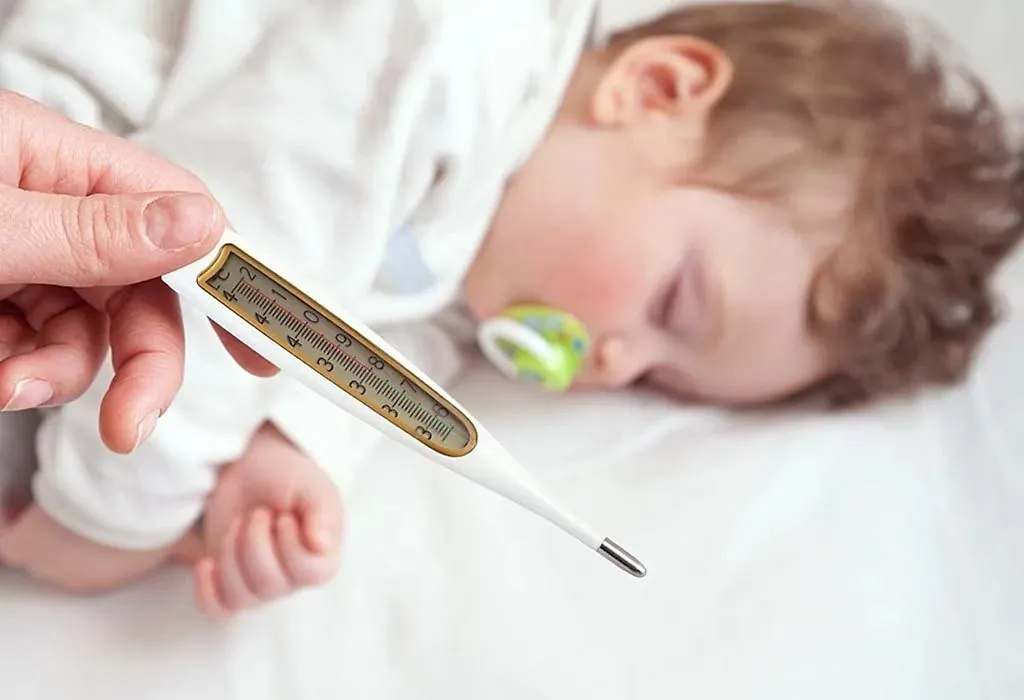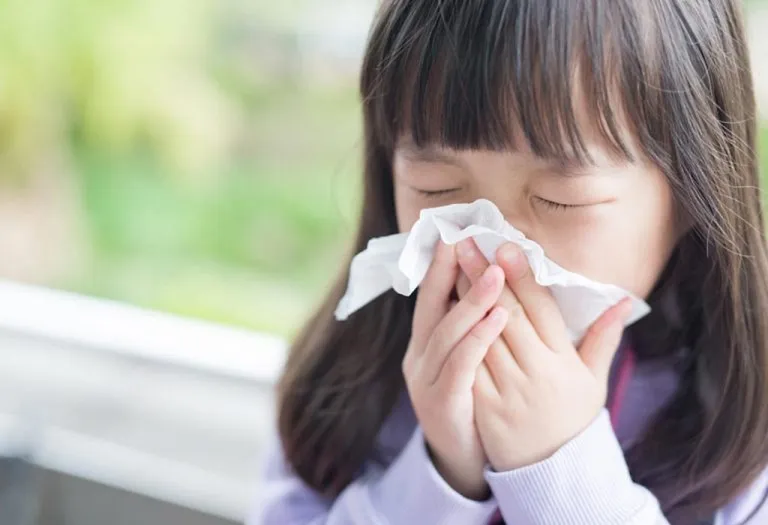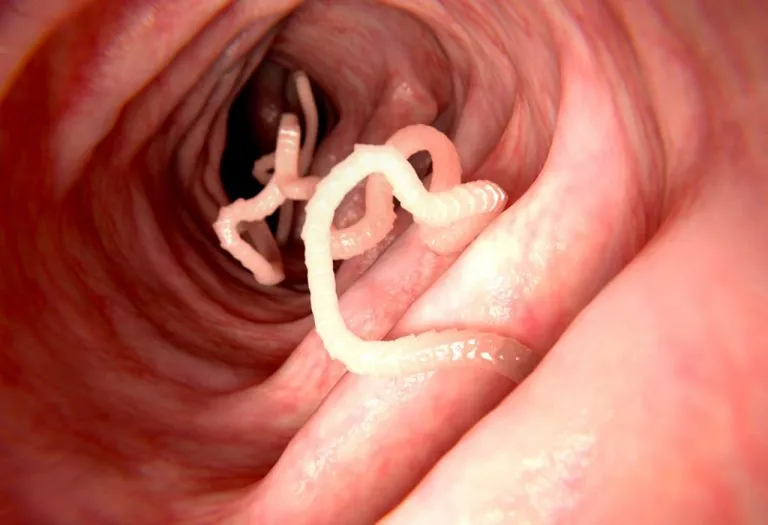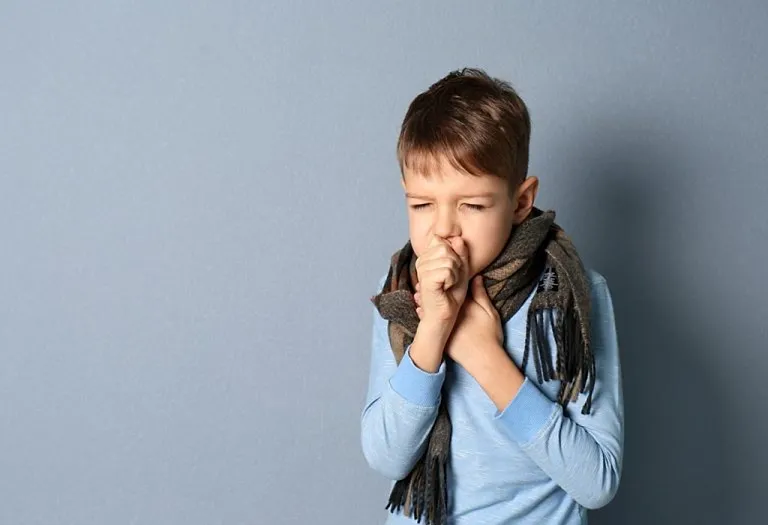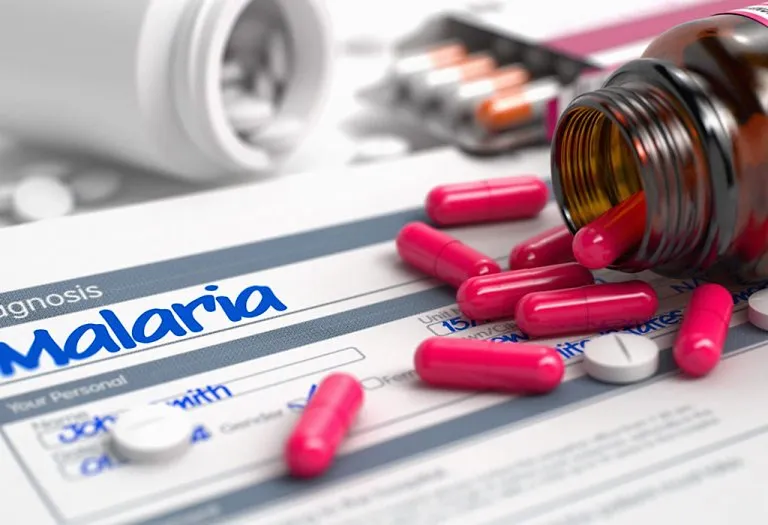Typhoid in Children – Symptoms, Causes and Treatment

- What Is Typhoid Fever?
- What Causes Typhoid in Children?
- Symptoms of Typhoid in Children
- Who Is At the Risk of Getting Typhoid?
- How Is Typhoid Fever Diagnosed?
- How Is Typhoid Treated in Children?
- Complications of Typhoid Fever in Children
- What’s the Recommended Diet for Your Child with Typhoid?
- Can Typhoid Be Prevented?
- FAQs
Your child’s mental and physical well-being must be your top priority. And we are sure you must do everything possible to keep your child safe and healthy. But we all fall sick, and so do our children. Sometimes, children may suffer from serious health problems which may require immediate medical attention. Typhoid, for instance, is a bacterial infection that can affect children. The symptoms of typhoid appear very quickly. Read this article to learn more about typhoid fever in children, its symptoms, causes, diagnosis, and treatment options.
What Is Typhoid Fever?
Typhoid fever is caused by Salmonella typhi infection. It spreads from one person to another, but if diagnosed early, it can be treated and won’t be fatal. The infection often contracts upon consuming contaminated water or food and is seen frequently among children (1). Once contracted, the infection first and foremost manifests as a persistent high fever, which gradually rises from 102°F up to 107°F (38.8°C to 41.6°C).
What Causes Typhoid in Children?
Children may suffer from typhoid fever if they do not maintain proper hygiene. A person suffering from acute typhoid can pass on the bacteria through stools, where the bacteria may survive for weeks in the sewage. Adults generally carry the pathogen, which they pass on through stools or urine (2).
Here are the causes of typhoid to watch out for and prevent:
- Eating contaminated food or drinking contaminated water (2).
- Poor hygiene, for instance, if hands are not washed frequently, especially after using the bathroom and before eating, can cause typhoid (3).
- Eating in places close to the sewage from dirty street vendors.
- Eating vegetables and fruits which are not thoroughly washed.
Symptoms of Typhoid in Children
The symptoms of typhoid may take a week or two after the infection, and they may range from mild to severe. Some typhoid symptoms in kids are given below:
1. High Fever
If your child has contracted a typhoid infection, the first and foremost symptom you will notice is a high fever. Typhoid fever may start as mild, but it can build up over a few days and may last long.
2. A Sore Throat
Having a sore throat is another symptom of typhoid in kids. If your child complains of discomfort in the throat and it is quite painful, they may have typhoid (4).
3. Fatigue and Weakness
Feeling exhausted for a long period despite getting good sleep can also signify typhoid. Sometimes, children experience extreme fatigue and weakness (5) from the infection, making it difficult to get up or sit without support.
4. Loss of Appetite
If you notice that your child is not interested in eating food, refuses to eat, and has a sore throat, then it may mean that the infection is present and persistent (6).
5. Diarrhoea
Children infected with typhoid may sometimes have a high fever accompanied by diarrhoea (6).
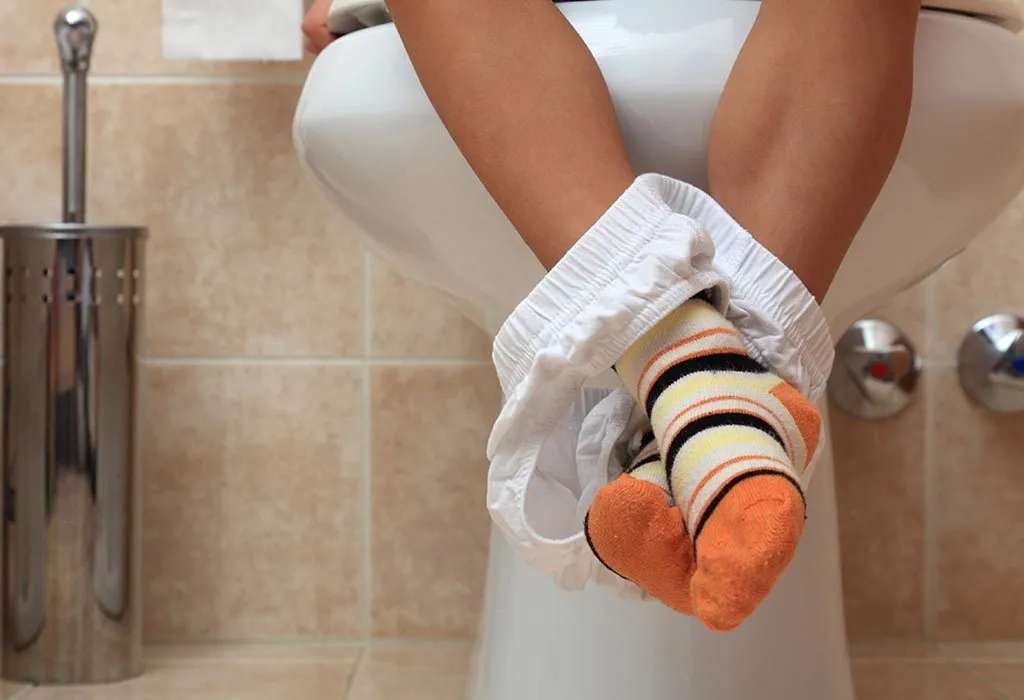
6. Abdominal Pain
If your child complains of acute pain in the stomach (6), then the chances of typhoid are quite high.
7. Constipation
If your child has difficulty passing stools and feels bloated for days, it is a sign of typhoid infection (6).
8. Headaches
Your little one could also complain of feeling heavy in the head and a prolonged headache due to the infection (7).
9. Swollen Belly
Some children may also have a swollen belly if they have typhoid (7). If you have noticed your child with a swollen belly, take them to a doctor immediately to get them checked for typhoid.
10. Coated Tongue
If your child complains of a sore throat, check their tongue immediately to see if it is coated. If it is, it is another sign of an infection (8).
Who Is At the Risk of Getting Typhoid?
Children exposed to the following factors have a high chance of developing typhoid:
- Poor access to clean drinking water
- Infrequent washing of hands before having a meal
How Is Typhoid Fever Diagnosed?
If you have noticed one or more of the signs in your child, such as a high fever, swollen belly, or rashes, your child may have typhoid fever. You must take them to a doctor to get the condition diagnosed.
- The doctor first asks for the symptoms related to the infection.
- The doctor will then check for high fever, rashes, and a coated tongue.
- The doctor will ask for medical history as well to confirm if there are any other complications.
- In addition, the doctor will suggest a blood test to diagnose typhoid fever. They may also suggest taking a stool or urine sample and testing it for bacteria to diagnose typhoid (9).
How Is Typhoid Treated in Children?
Treating typhoid in its early stages is important or can prove fatal. Your child’s doctor will suggest a blood test to diagnose the condition, and depending on the blood test result, They may suggest an antibiotic (10), which should ideally be taken daily for 7 days. You must ensure that your child takes the entire course of medicines even if They feel better. If you stop the course of treatment in between, chances are that some bacteria will remain in your child’s body, and they may fall sick again.
Apart from giving your child medicines, the treatment of typhoid in children includes offering them plenty of fluids to prevent dehydration. Make them stay home and rest until they recover completely and the bacteria is gone. A preventive vaccine can also be orally given along with a booster for children six years or older (11), but the best thing you can do is keep your child in a clean environment.
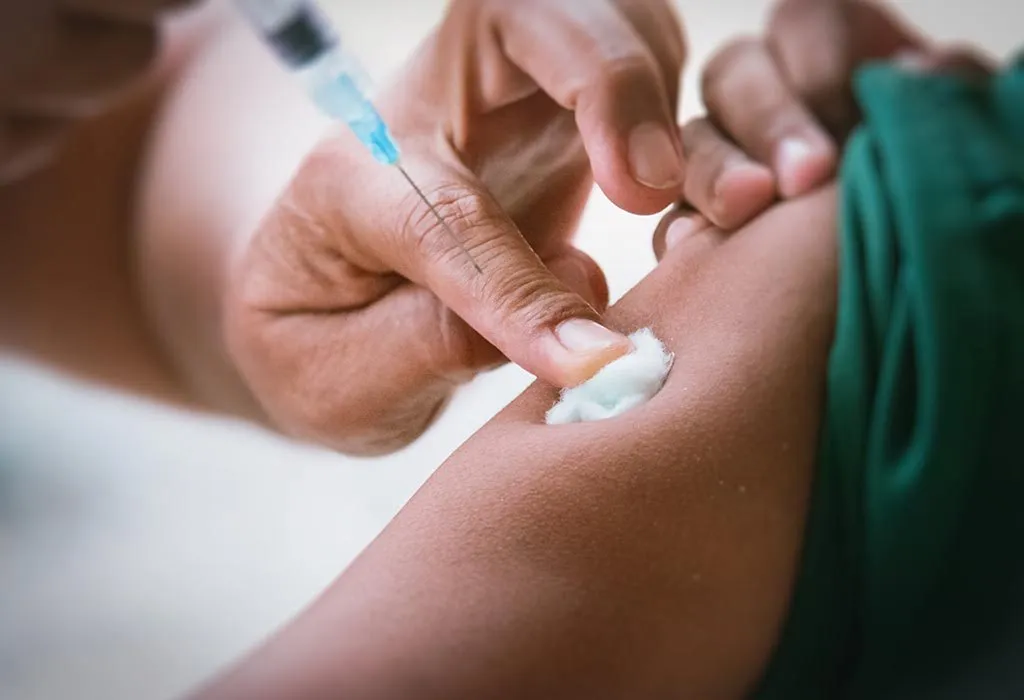
Complications of Typhoid Fever in Children
If the symptoms of typhoid or the infection are not addressed immediately, they can lead to several complications in children. If your child doesn’t get the antibiotics on time, it can prove fatal. Here are some complications that may arise if typhoid fever persists for a long time in your child.
- By the third week of the infection, the complications start to show very severely. One of them is internal bleeding in the digestive system (12).
- Internal bleeding leads to pale skin, breathlessness, vomiting blood, and passing dark or tar-like stools (12).
- Perforation is the splitting of a section in the intestines, which results in septic shock. This serious and dangerous complication may arise because of typhoid (12).
What’s the Recommended Diet for Your Child with Typhoid?
It is vital to feed your child the right food when they are battling typhoid to ensure their energy levels are high and they recover quickly. Also vital is giving them plenty of fluids, whether water, milk or freshly squeezed juice. This is because they lose a lot of water during typhoid due to diarrhoea, vomiting, or sweating due to fever and extreme pain. Avoid caffeinated drinks, energy drinks, and store-bought sugary juices/drinks.
Additionally, they should be fed light food that is mildly spiced and not oily. Feed as much as they want for little ones who are still breastfed. If you feed them formula, do so every half an hour.
Can Typhoid Be Prevented?
The first thing you should do is ensure your child washes their hands before and after eating and after using the toilet. They should follow healthy hygiene practices and stay in a clean, hygienic environment free of most infections. This doesn’t mean you do not allow your children to play outside, but you should take certain precautions to prevent typhoid.
- Offer them cooked food – Ensure your child eats only cooked food and nothing raw. For instance, if your child wants meat, cook it before giving it to them. They should not consume raw meat as it may lead to health problems. Avoid giving them street food and packaged food. Street vendors may cook food in unhygienic places, so you better avoid taking the risk. Raw fruits should also not be given to kids. While making a vegetable or vegetable curry for your child, clean the veggies well and cook them well before giving them to your child. Offer them only pasteurised dairy products and eggs when giving them dairy products (1).
- Ensure they have access to clean drinking water – As a parent, you are responsible for caring for your little one. You should take preventive measures to prevent your child from illnesses. You must ensure they drink only sterilised and clean water to prevent typhoid. You can even boil the water before giving it to your child (1).
- Ensure they wash their hands thoroughly – Ensure your child always washes their hands with soap and warm water after using the bathroom and before meals. You can also ask them to use a sanitiser if needed. Get them into the habit of washing hands and feet as soon as they step into the house after playing outdoors (1).
FAQs
1. Is typhoid fever still prevalent?
Yes, according to a survey done by the World Health Organisation in 2019, over 9 million people contract typhoid, 110,000 of whom die annually. So, it is crucial to take all measures to prevent your child from contracting the disease (1).
2. Is there a vaccine for typhoid?
Yes, three main types of typhoid vaccines can be administered:
- Typhoid conjugate vaccine (TCV), which can be injected in children from 6 months of age (13)
- Unconjugated polysaccharide vaccine for children aged two years and above (13)
- An oral vaccine in capsule formulation for those over six years of age (13)
If typhoid is not treated well in time, it can lead to serious, life-threatening complications in your child. So, immediately take your child to a doctor if you notice any of the above symptoms. Also, maintain hygiene in your house to prevent it from spreading. Maintain hygiene and keep health problems at bay.
References/Resources:
1. Typhoid; World Health Organisation; https://www.who.int/news-room/fact-sheets/detail/typhoid?
2. Typhoid Fever ; Nemours Kid’s Health; https://kidshealth.org/en/parents/typhoid.html
3. Kim, C., Goucher, G.R., Tadesse, B.T., Lee, W., Abbas, K., and Kim, J.H.; Associations of water, sanitation, and hygiene with typhoid fever in case-control studies: a systematic review and meta-analysis; BMC Infect Dis; https://www.ncbi.nlm.nih.gov/pmc/articles/PMC10464135/; August 2023
4. Typhoid and paratyphoid; Better Health Channel; https://www.betterhealth.vic.gov.au/health/healthyliving/typhoid-and-paratyphoid
5. Typhoid Fever; NHS; https://www.nhs.uk/conditions/typhoid-fever/
6. Typhoid Fever; Cleveland Clinic; https://my.clevelandclinic.org/health/diseases/17730-typhoid-fever
7. Typhoid Fever; Mayo Clinic; https://www.mayoclinic.org/diseases-conditions/typhoid-fever/symptoms-causes/syc-20378661
8. Bal, S.K. and Czarnowski, C.; A man with fever, cough, diarrhea and a coated tongue; CMAJ; https://www.ncbi.nlm.nih.gov/pmc/articles/PMC374215/; March 2004
9. Typhoid and Paratyphoid Fever – Symptoms and Treatment; Center for Disease Control and Prevention; https://www.cdc.gov/typhoid-fever/symptoms.html
10. Dahiya, S., Malik, R., Sharma, P., Sashi, A., Lodha, R., Kabra, S.K., Sood, S., Das, B.K., Walia, K., Ohri, V.C., and Kapil, A.; Current antibiotic use in the treatment of enteric fever in children; Indian J Med Res; https://www.ncbi.nlm.nih.gov/pmc/articles/PMC6563751/; February 2019
11. Typhoid Vaccine Information Statement; Center for Disease Control and Prevention; https://www.cdc.gov/vaccines/hcp/vis/vis-statements/typhoid.html
12. Typhoid Fever – Complications; NHS; https://www.nhs.uk/conditions/typhoid-fever/complications/
13. Immunisations, Vaccines, and Biologicals – Typhoid; World Health Organisation; https://www.who.int/teams/immunization-vaccines-and-biologicals/diseases/typhoid
Also Read:
Encephalitis in Kids
Kawasaki Disease in Kids
Measles(Rubeola) in Children
Combating Chronic Health Conditions in Children



